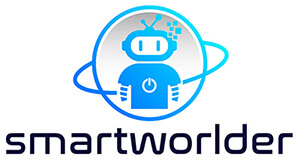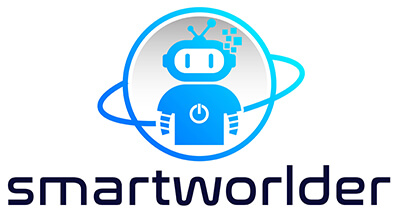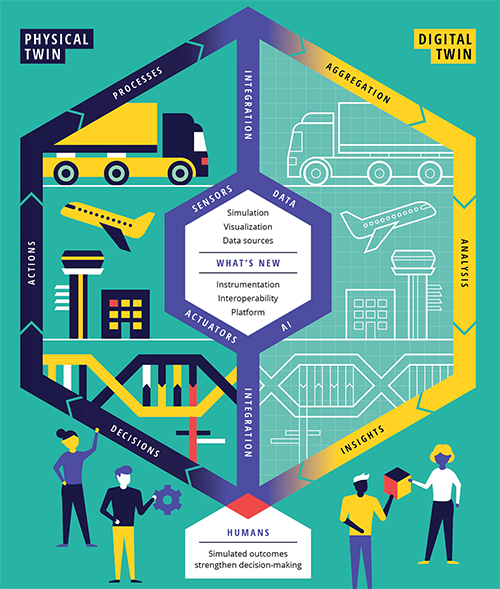Digital Twin
Content
A Digital Twin is an exact digital replica or virtual representation of a physical object, place, process, product, or service that spans its lifecycle. It uses real-time data and other sources to enable monitoring of systems, to prevent problems before they occur, to develop new management strategies, opportunities, and to improve decision-making.
A digital twin consists of three components: the physical entities, the virtual models, and the connected data that is shared back and forth between them. In particular, developments in sensor technologies and wireless networks have pushed forward the applications of the Internet of Things (IoT) and contributed to the practical applications of digital twin technology.
How Does A Digital Twin Work?
In creating a digital twin, an object – for example, a jet engine – is outfitted with sensors related to vital areas of functionality. These sensors produce data about different aspects of the engine’s performance, such as fuel intake, thrust, temperature, air mass flow rate, etc. This data is then relayed to a computer with the appropriate software applications to create and manage a digital copy.
Once informed with such data from the connected sensors, combined with other sources of information, the virtual model can be used to run simulations, study performance issues and generate possible improvements. This makes a digital twin a valuable tool to help engineers, operators and planners to understand not only how physical objects, systems or services are performing, but how they will perform in the future. These insights can then be applied back to the original physical object for fine-tuning, redesign, upgrades, etc.
In other words, digital twins enable learning and discovering new knowledge, new hypothesis generation and testing, and experiments and comparisons by means of computer modelling or computer simulation.
Digital twins go beyond traditional models and simulations by dynamically linking the physical and digital worlds, and leveraging modern technologies, such as smart sensor technology, big data analytics, and artificial intelligence (AI) in order to detect and prevent system failures, improve system performance, and explore innovative opportunities. The ability to predict how the physical object or process will perform gradually increases in accuracy thanks to integration with AI and advanced analytics. This ability leads to the predicted outcomes being shared as part of the information feedback to the original physical entity.
The ultimate goal for digital twins is to iteratively model, test, and optimize a physical object in the virtual space until that model meets expected performance, at which point it is then ready to be built or enhanced (if already built) in the physical world.
The Conceptual Architecture of Digital Twins
The conceptual architecture of digital twins, as illustrated above, is best understood as a sequence of six steps:
1. Processes: A physical process is equipped with sensors that measure the input data of both the process itself and its environment. The signals from the sensors can be supplemented with information from the processes of other company systems, such as supply chain systems, resource planning, etc. In this way, the digital twin receives a wide range of continuously updated input data, which it will then use for analysis.
2. Integration between the twins is carried out through various communication interfaces that help transfer information from the sensor to the integration function. To ensure secure integration, encryption keys, firewalls, and device certificates must be used.
3. Aggregation: Receiving processed and prepared data for analysis in data storage. Data aggregation and processing can be on-premises or in the cloud, the choice is up to the company.
4. Analysis: Data analysis and visualization. Analysis can be carried out both independently by analysts, and with the support of analytical decision-making systems that develop recommendations and send them to specialists.
5. Insight: visualization and highlight of critical deviations in the physical analog performance in one or more dimensions, indicating potential areas for further research and correction.
6. Decisions and Actions: Putting optimization ideas into practice and changing the existing process. Updating information in the internal systems of the digital twin according to the changes made. This stage is completely dependent on human intervention. This interaction closes the circle of connection between the physical and digital world.
Benefits of Digital Twins
The use of digital twins leads to more effective research and design, with an abundance of data created about likely performance outcomes. That information can lead to insights that help organizations make needed refinements and finding and eliminating shortcomings to improve the quality of the service or product before starting production or service launch.
During operation, digital twins help mirror and monitor production and other live operation systems, with an eye to achieving and maintaining peak efficiency throughout the entire process. For instance, if sensors on a wind turbine pick up a deviation from the target performance, the digital twin can be used to run simulations, study the likely cause of the performance issues, and generate possible improvements.
History of Digital Twin Technology
According to IBM’s digital twin white paper, the idea of digital twin technology was first voiced in 1991, with the publication of Mirror Worlds, by David Gelernter. Dr. Michael Grieves (then on faculty at the University of Michigan) is credited with first applying the concept of digital twins to manufacturing in 2002 and formally announcing the digital twin software concept. Eventually, NASA’s John Vickers introduced a new term – digital twin – in 2010.
However, the core idea of using a digital twin as a means of studying a physical object can actually be witnessed much earlier. In fact, it can be rightfully said that NASA pioneered the use of digital twin technology during its space exploration missions of the 1960s, when each voyaging spacecraft was exactly replicated in an earthbound version that was used for study and simulation purposes by NASA personnel serving on flight crews.
Probably the most famous historical example of a digital twin was Apollo 13 in 1970, which was created to simulate the conditions of the spacecraft before and after launch. During the flight, several oxygen tanks exploded on board, causing an emergency that put the crew at risk. The virtual model of Apollo 13, which allowed the engineering team on the ground to solve problems from a distance of thousands of kilometers, was the decisive factor in the rescue of the three astronauts on board.
Applications of Digital Twins
Digital twins are becoming an important tool not only in business, but the technology and applications of digital twins have been rapidly developing in several other fields as well: engineering and design of cars and airplanes, safety-relevant infrastructure like tunnels, bridges and wind turbines, electronics, and the design of process function and production line capabilities in smart factories. Also, digital twins are becoming a powerful tool for smart city planners where a multitude of systems needs to be managed.
Cybersecurity may also fit neatly into the digital twin portfolio as they could be employed to protect 3D printing and other manufacturering ptocesses from cyberattacks. Because manufacturing processes produce such rich data sets – temperature, voltage, current – and they are so repetitive, there are opportunities to detect anomalies that stick out, including cyberattacks by making use of digital twins.
Frequently Asked Questions (FAQs) about Digital Twins
What is a digital twin?
Digital twins are virtual replicas of physical devices, systems, or processes that can be used for various purposes such as simulation, analysis, and monitoring. They allow for real-time data analysis and system updates.
How do digital twins work?
Digital twins work by collecting real-world data from sensors installed on the physical counterpart, which is then used to create a dynamic, digital simulation. This simulation can predict performance, optimize operations, and identify potential issues before they occur.
What are the benefits of using digital twins?
The benefits include improved efficiency, reduced operational costs, enhanced product development, predictive maintenance, and the ability to test the impact of changes in a virtual environment before applying them in the real world.
In which industries are digital twins used?
They are used across various industries, including manufacturing, healthcare, automotive, aerospace, urban planning, and energy, to optimize processes, enhance performance, and improve decision-making.
What is the difference between digital twins and traditional simulation models?
Unlike traditional simulation models, digital twins are continuously updated with real-time data, making them more accurate and allowing them to evolve alongside their physical counterparts.
How do digital twins integrate with IoT (Internet of Things)?
Digital twins integrate with IoT by utilizing data from IoT devices and sensors to update and maintain the digital replica, ensuring it accurately reflects the current state of the physical object or system.
What are the challenges of implementing digital twins?
Challenges include the high initial setup costs, the need for expertise in data analysis and simulation, ensuring data privacy and security, and integrating the digital twin with existing systems and technologies.
How can digital twins improve decision-making processes?
By providing a detailed and accurate representation of physical assets in real-time, digital twins enable businesses to make informed decisions, predict outcomes, and optimize operations without the risk of real-world trial and error.
What is the future of digital twins?
The future of digital twins includes wider adoption across industries, enhanced integration with AI and machine learning for predictive analytics, and the potential to become standard practice for managing complex systems and processes.
How do you create a digital twin?
Creating a digital twin involves defining the scope and objectives of the twin, collecting and integrating data from the physical counterpart, developing a virtual model, and continuously updating it with real-time data for accuracy.
Check out our SmartWorlder section to read more about smart technologies.




